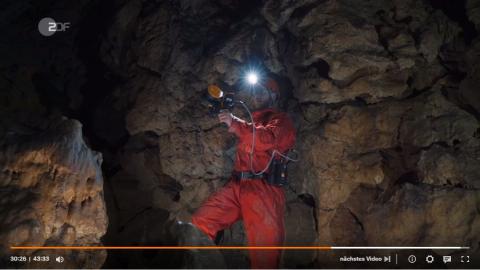Laserscanning Europe's GeoSLAM scanner in action at Terra X documentation
Research diver and underwater archaeologist Florian Huber successfully used the GeoSLAM ZEB Horizon during an expedition in Wimsen Cave, the deepest underwater cave in Germany.
With the help of the mobile laser scanner, the so-called treasure chamber in the Wimsen Cave was surveyed. Bronze Age bone finds were also made at this site, which have led to speculation for years.
We are pleased that we were able to enable Florian Huber to survey with the GeoSLAM Horizon and are excited to see what insights can be gained from the data!
Watch the documentary "Secrets from the Deep" of the successful science programm Terra X in the ZDFmediathek. This documentary ran in prime time on Germany's 2nd national television. From 29:47 you can see the survey of the treasure chamber with the ZEB Horizon from GeoSLAM.

Read more information on the Terra X episode:
In the new Terra X episode with Florian Huber, Lake Walchen, the Wimsen Cave, the Baltic Sea and the Kosterhavet National Marine Park are the underwater archaeologist's new diving destinations.
The Terra X documentary "Secrets from the Deep" follows underwater archaeologist and research diver Florian Huber on his expeditions into hidden underwater worlds and shows what makes them so unique, challenging and sometimes dangerous.
Florian Huber's job is anything but monotonous: he is a research diver and underwater archaeologist at the same time. He spends much of his time scientifically investigating unexplained wreck finds. But Florian Huber and his team are also concerned with the protection of marine biodiversity, the exploration of spectacular underwater caves, and the development of modern methods for underwater archaeology. For the Terra X documentary "Secrets from the Deep," the researcher is traveling in Germany and Sweden, discovering hidden places and forgotten stories. One of them is about Lake Walchen. At 192 meters, it is the deepest mountain lake in Germany. Numerous myths surround this body of water south of Munich. The lake is said to be bottomless, unfathomable and full of treasures. For many centuries, people also believed that a huge primeval catfish lived at the bottom of the lake and could flood the entire region, including the state capital, with a single flap of its fins. During World War II, the lake became a watery grave when a British "Avro Lancaster" bomber crashed into the waters, killing the crew of seven. After more than 75 years, Florian Huber is the first to scientifically examine the remains of the aircraft.
Von Bayern aus reist der Forscher in den hohen Norden von Schweden. Direkt an der Grenze zu Norwegen erstreckt sich der Meeresnationalpark Kosterhavet. Das Besondere: Etwa 97 Prozent des Schutzgebiets liegen unter der Meeresoberfläche. Es sind die mehr als 12.000 Tier- und Pflanzenarten, die dieses Gebiet so einzigartig machen. Dazu gehören unter anderem die „Kleine Seenadel“, der „Nagelrochen“, Seeanemonen und Korallen. Im über 200 Meter tiefen Kostergraben, einer Verwerfungsrinne, die vor Millionen von Jahren entstanden ist und sich bis in den Nordatlantik erstreckt, leben seltene Tiefseearten. Florian Huber geht mit Meeresbiologen auf einen Tauchgang in die spektakuläre Unterwasserwelt des Koster-Archipels.
From Bavaria, the researcher travels to the far north of Sweden. The marine national park Kosterhavet stretches directly along the border with Norway. The special feature: About 97 percent of the protected area lies beneath the sea surface. It is the more than 12,000 animal and plant species that make this area so unique. These include the "little sea needle", the "thornback ray", sea anemones and corals. Rare deep-sea species live in the more than 200-meter-deep Kostergraben, a fault channel that was formed millions of years ago and extends into the North Atlantic. Florian Huber goes on a dive with marine biologists into the spectacular underwater world of the Koster Archipelago.
Florian Huber is particularly fascinated by one wreck: the "Hedvig Sophia" - the former flagship of the Royal Swedish Navy and pride of the nation. The Swedish warship ran aground in the Kiel Fjord in April 1715 during a bloody sea battle between Denmark and Sweden. The "Hedvig Sophia" was discovered in 2008, and the first preliminary investigations began a year later. Florian Huber was part of the team back then. Now he is once again diving down to the remaining relics at the bottom of the Baltic Sea to check their state of preservation. The remains will not be recovered, because salvaging and expert conservation would involve costs that most institutions cannot afford. Therefore, underwater archaeologists are constantly looking for new ways to document their work and also make it accessible to a larger audience. One possibility is revealed by the Roman-Germanic Central Museum in Mainz. There, Florian Huber meets the head of digital technologies, Professor Michael Orthwein. His idea is to turn museum visitors from spectators into witnesses of science, using VR technology to venture on a virtual dive to shipwrecks. Florian Huber puts it to the test: Using a VR headset, he beams himself onto the "Madrague de Giens," a Roman shipwreck from the 1st century BC.
The film follows Florian Huber to the various sites and documents the researcher's work.